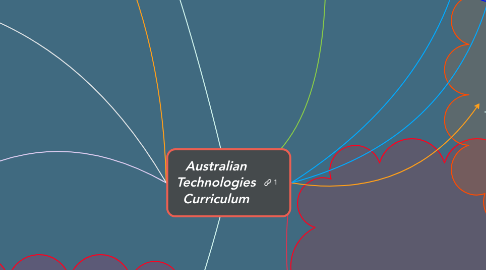Australian Technologies Curriculum
by Steven Styles


1. Processes and Production Skills
1.1. Investigating and defining
1.2. Designing
1.3. Producing and Implementing
1.4. Evaluating
1.5. Collaborating and Managing
2. Curriculum Aims and Objectives
3. Design and Technologies
3.1. -produce designed solutions suitable for a range of Technologies contexts by selecting and manipulating a range of materials, systems, components, tools and equipment creatively, competently and safely; and managing processes
3.2. - understand the roles and responsibilities of people in design and technologies occupations and how they contribute to society.
4. Design and Technologies Content Strand
4.1. Knowledge and Understanding
4.1.1. Technologies and Society
4.1.2. Technologies Contexts
5. Overall
5.1. -investigate, design, plan, manage, create and evaluate solutions
5.2. -creative, innovative and enterprising when using traditional, contemporary and emerging technologies, and understand how technologies have developed over time
5.3. -make informed and ethical decisions about the role, impact and use of technologies in the economy, environment and society for a sustainable future
5.4. -engage confidently with and responsibly select and manipulate appropriate technologies, materials, data, systems, components, tools and equipment when designing and creating solutions
5.5. -critique, analyse and evaluate problems, needs or opportunities to identify and create solutions.
6. Band Levels
6.1. Foundation to Year 2
6.2. Year 3 and 4
6.3. Year 5 and 6
6.4. Year 7 and 8
6.5. Year 9 and 10
7. Cross Curriculum Priorities
7.1. Aboriginal and Torres Strait Islander Histories and Cultures
7.2. Asia and Australia's Engagement with Asia
7.3. Sustainibility
8. Achievement Standards
8.1. From Pre-primary to Year 10, achievement standards indicate the quality of learning that students should typically demonstrate by a particular point in their schooling. An achievement standard describes the quality of learning (e.g. the depth of conceptual understanding and the sophistication of skills) that would indicate the student is well-placed to commence the learning required at the next level of achievement.
9. Key Concepts
9.1. abstraction, which underpins all content, particularly the content descriptions relating to the concepts of data representation, and specification, algorithms and implementation
9.2. data collection (properties, sources and collection of data), data representation (symbolism and separation) and data interpretation (patterns and contexts)
9.3. specification (descriptions and techniques), algorithms (following and describing) and implementation (translating and programming)
9.4. digital systems (hardware, software, and networks and the internet)
9.5. Interactions (people and digital systems, data and processes) and impacts (sustainability and empowerment).
10. Content Descriptions
10.1. Content descriptions at each band describe the knowledge, understanding and skills that teachers are expected to teach and students are expected to learn. A concept or skill introduced in one band may be revisited, strengthened and extended in later bands as needed. Content descriptions do not prescribe approaches to teaching. Content descriptions in each subject across the bands focus on similar organising elements that present a developmental sequence of concepts, skills and processes.
11. Digital Technologies
11.1. -use computational thinking and the key concepts of abstraction; data collection, representation and interpretation; specification, algorithms and implementation to create digital solutions
11.2. -confidently use digital systems to efficiently and effectively transform data into information and to creatively communicate ideas in a range of settings
11.3. -apply systems thinking to monitor, analyse, predict and shape the interactions within and between information systems and understand the impact of these systems on individuals, societies, economies and environments.
12. Digital Technologies Content Strand
12.1. Knowledge and Understanding
12.1.1. Digital Systems
12.1.2. Representation of Data
12.2. Digital Implementation
12.3. Processes and Production Skills
12.3.1. Collecting, Managing and Analysing data
12.3.2. Creating Solutions
12.3.2.1. Investigation
12.3.2.2. Design
12.3.2.3. Production and Implementation
12.3.2.4. Evaluation
12.3.2.5. Collaboration and Management
13. General Capabilites
13.1. LITERACY
13.2. NUMERACY
13.3. iNFORMATION AND COMMUNICATION TECHNOLOGY (ICT) CAPABILITY
13.4. CRITICAL AND CREATIVE THINKING
13.5. PERSONAL AND SOCIAL CAPABILITY
13.6. ETHICAL UNDERSTANDING
13.7. INTERCULTURAL UNDERSTANDING
14. Steven Styles
15. Content Elaborations
15.1. Content elaborations are provided for each content description in Foundation to Year 10 to illustrate content. They are intended to help teachers in developing a shared understanding of the content descriptions. They are not intended to be comprehensive content points that all students need to be taught nor do they encompass every aspect of a content description.
16. Key Ideas
16.1. Overarching idea: Creating preferred futures
16.2. Project management
16.3. Thinking in Technologies
16.3.1. Systems thinking
16.3.2. Design thinking
16.3.3. Computational thinking
17. Student Diversity
17.1. The three-dimensional design of the Western Australian Curriculum, comprising learning areas, general capabilities and cross-curriculum priorities, provides teachers with flexibility to cater for the diverse needs of students across Western Australia and to personalise their learning.
17.1.1. Students with disability
17.1.2. English as an additional language or dialect
17.1.3. Gifted and talented students
